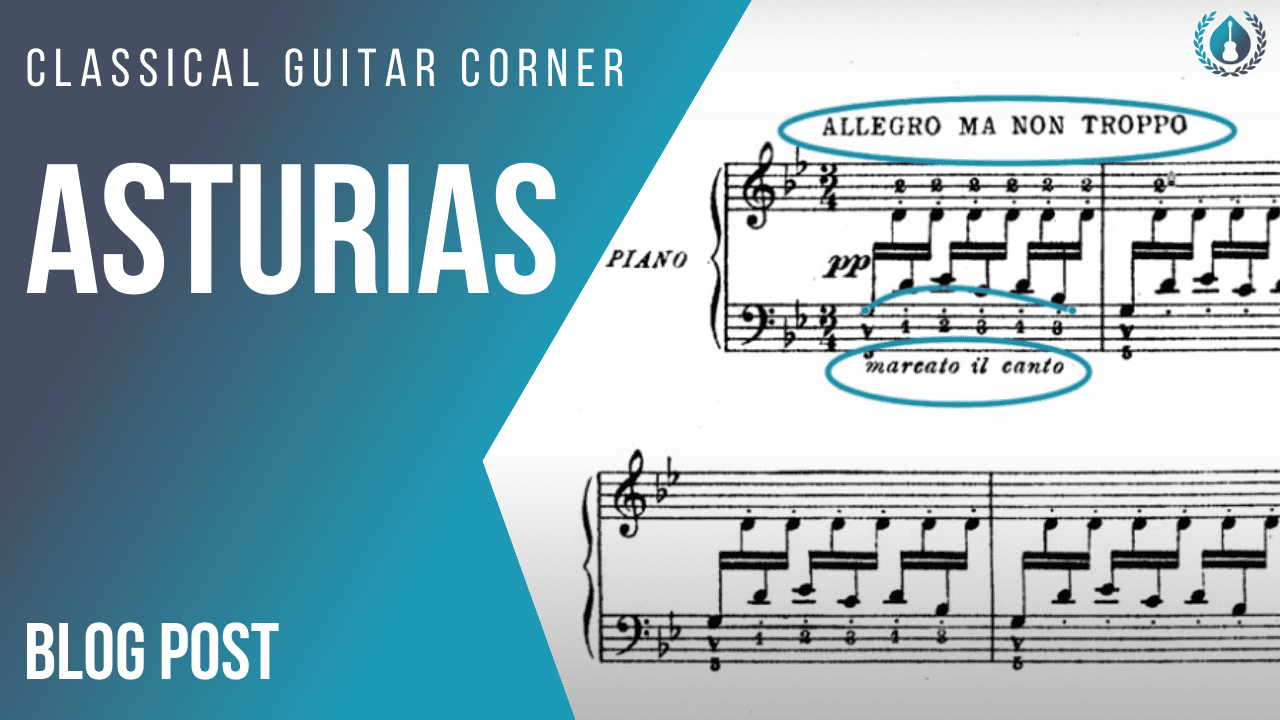In this Asturias (Leyenda) workshop we’ll take a deep dive into this wonderful piece of music by Spanish composer Isaac Albéniz.
Asturias (Leyenda) Workshop
Where is Asturias? Why does this piece have more than one title? How on earth is one of the most popular guitar pieces not even written for the guitar?! Join me on a fun exploration of all these questions and a deep dive into how to play and listen to this classic. (The workshop took place live and starts at approximately 9:08.)
Not Asturias?
This piece is one of the most recognizable pieces of music on classical guitar. However, it is not a composition for the guitar. Albéniz originally wrote it for the piano. In fact, its original title was not Asturias (or Leyenda), but “Prelude.” This particular prelude is included in Albéniz’s Chants d’Espagne (Songs of Spain). Later a publisher collected several different pieces into “Suite Española” giving the piece its now legendary title.
Flamenco
Asturias (Leyenda) borrows a lot from the world of flamenco music. Inspired by his teacher Felipe Pedrell, Albéniz began to compose music that was distinctly Spanish. This was one of the first of his nationalistic pieces of music. For example, we can notice the stomps of dancers’ feet in the big accented chords or the “cante jondo” style of flamenco singing in the melody line.
Asturias on Classical Guitar
Unlike so many other pieces written for other instruments, arguably Asturias sounds better on the guitar. The most popular arrangement of the piece is that of Andrés Segovia. There are some interesting changes that Segovia made. For instance, the triplets in the accompaniment add drive to the music, but they were not in the original piano score.
Learn more about Isaac Albéniz
If you would like to read more about the composer, Issac Albéniz, you can read Dave Belcher’s excellent article: Issac Albéniz : A Portait.


Well, I’ve never been to Spain. But I kinda like the music…
This was great, Simon. Well done.
It is a beautiful piece – on both instruments, piano and guitar.
I had the opportunity to see a recital by Ana Vidovic last night and Asturias was one of the pieces she played — magnificently!!! The whole evening was an incredible experience.
I appreciate how much research and effort must go into creating a video such as this one so I must express my gratitude to Mr. Powis for taking the time and energy to make this for all to enjoy, although I suppose it is only those who really like music and especially classical guitar music who will bother to watch it to the end.
I am a long way from being able to play this piece but nonetheless I can enjoy it even more when I listen to it just knowing now how difficult it is to play and also how much the musician must have devoted to his or her craft in order to perform it well.
So again to Mr. Powis for his deep and very engaging insights into this most famous and popular piece of Spanish music.
Permit my rambling about the title. Leyenda? (“Legend” in Spanish). Legend about what? And why the alternate title of Asturias for music so Andalucian? Asturias is the northern strip of mining country and only region not conquered by the Moors. It took me years to conclude the following: When Dom Pelayo led a band of knights out of a cave in Asturias he began the 800-year “Reconquista.” It ended in 1492 in Granada, site of the Alhambra, that masterpiece of Moorish architecture near the gardens of the Generalife. Think of the strong characteristic chord pattern (B?) in the first section, repeated in the third. I think it suggests Dom Pelayo’s determined knights emerging from the cave banners flying on their raised lances. That pattern gives way and later alternates with a pattern suggestive of the oriental sensuality in the Alhambra. Hence the legend. I first heard this piece in Segovia’s “Espana” album in 1969, and I’ve never been the same since.
Thanks for those fascinating thoughts, Daniel!
Peace,
Dave B (CGC team)